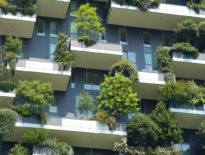Living Building at Georgia Tech on Leading Edge of Biophilia Imperative
Your confusion might be excused if you stumbled one morning last August into a conference room on the Georgia Tech campus.
More than 50 people sat at eight tables. Most wore casual business attire. Almost all were design or construction professionals, planning the landmark Living Building at Georgia Tech.
The unusual thing was that some participants were scrutinizing sticks, bones, shells, and even coral. Volunteers were walking around the room to dole out tiny spoonfuls of honey. And, at one point, the soothing voice of the moderator urged participants to close their eyes for a few minutes, so they could pay attention to the sounds around them.
It wasn’t your typical integrated project team meeting. With the adoption two years ago of Living Building Challenge 3.0, biophilic design workshops have become part of the LBC certification process. The standard now requires each building’s team to “engage in a minimum of one all-day exploration of the biophilic design potential for the project.” It also calls for that “exploration” to “result in a biophilic framework and plan for the project.”
The LBC’s Biophilic Environment Imperative may be the building industry’s most formal adoption yet of a concept that has had a hard time breaking past the theoretical stage.

Like any big subject, the word “biophilia” draws deceptively simple definitions. The celebrated psychoanalyst Erich Fromm coined it in 1964 to mean “love of life or of living systems.” Twenty years later, in a book called The Biophilia Hypothesis, evolutionary biologist Edward O. Wilson put a more active spin on the definition: “the urge to affiliate with other forms of life.”
Biophilia is one of those concepts that seems to brush up against everything. Sight. Touch. Smell. Taste. Sound. All senses connect us to plants, animals, and nature. The same is true for experiences: How we move. How we work. How we relax. We almost always play those roles in ways that relate to other living things.
The concept has multiple, layered applications in the building sector. “Biophilic design” can refer to a reliance on natural materials, to products or designs that evoke plants or animals, or to designs that connect us to nature.
Such ideas have always been with us. Architects have long thought about designing structures that befit our core human nature. Engineers and builders have long mimicked the tricks of living organisms.
Biophilic design consultant Sonja Bochart notes a key distinction, however. She sees the practice as grafting an intentional, scientific approach onto the art of incorporating living themes into buildings.
“Happiness, satisfaction, overall well-being—there are proven links between those goals and specific patterns of living systems,” she says in an interview.
While leading the Georgia Tech workshop in August, Bochart pointed to a landmark 1984 study by Roger S. Ulrich, which determined that surgery patients in rooms with views of nature recovered more quickly than those with views of brick walls. Ulrich’s study often is the first cited in a rich vein of findings about our evolutionary connection to nature, and the impact it can have on our happiness and well-being: Our blood pressure drops when we look at animals. Plants lower stress levels. Natural light improves productivity and morale.

Until about a decade ago, Bochart was a Phoenix-based interior designer and fitness enthusiast, who struggled to enhance the well-being of occupants in her buildings. The late professor of social ecology at Yale University Stephen R. Kellert provided a framework for the issues she was struggling to address. He made the practice of biophilic design manageable by breaking it into six elements: environmental features, natural shapes and forms, natural patterns and processes, light and space, place-based relationships, evolved human-nature relationships. (Read more here.)
Even before the Living Building Challenge adopted the Biophilic Environment Imperative, Bochart helped Richard Piacentini of the Phipps Conservatory in Pittsburgh to devise a biophilic strategy for Phipps’ Center for Sustainable Landscapes, which achieved LBC certification in 2015. That relationship yielded a slew of creative applications of biophilic design, including a sound installation called “Of Earth and Sun.” Artist Abby Aresty spent months recording birds, wind, rain, insects, and other natural sounds in Pittsburgh. The recordings were arranged into an “algorithmically generated audio collage,” which is amplified through the atrium’s windows via vibrations generated by tiny transducers. The result is a sort of subtle play on “surround sound.” It is very calming.
LBC’s new Biophilic Imperative allowed Bochart to engage early on in the Living Building at Georgia Tech. Even with that start, some aspects of the building’s design were coming together before she got involved. The most obvious example is the building’s basic scheme, which calls for a huge porch and lots of windows that invite views of the university’s nearby regenerative landscape project, called the Eco-Commons.

In biophilic terms familiar to many architects, the porch offers both “prospect”—because it provides an open view of the landscape to the west—and “refuge”—because it’s a protected zone. Those two features have been found in numerous studies to reduce stress, boredom, and fatigue, and to enhance comfort, concentration, and sense of safety.
“It’s difficult to separate this stuff,” says Dennis Creech, the Atlanta green-building guru and Southface Energy Institute founder, who’s consulting for Kendeda on the project at Tech. “When is something biophilic design versus just plain old good design?”
Bochart says that’s part of the point. She wants architects, engineers, owners, and builders to think about the intersection between overall design and specific biophilic features that can enhance the health and experience of occupants.
“What we’ve found is that it really requires a site-specific approach,” she says. “There’s an intuitive way of designing that’s very much in tune with time-honored aspects that put us in touch with nature. But it helps to remember the patterns that research tells us are tied to satisfaction and well-being.”
The workshop she led at Georgia Tech was only her second since the Imperative was adopted. The building’s location on the campus of a major research university allowed Bochart to tap into some formidable brainpower. Jeanette Yen, a biology professor who directs the university’s Center for Biologically Inspired Design, helped Bochart gather the show-and-tell artifacts for the meeting. She started a brief presentation by throwing a maple seed pod into the air, so that everyone could watch it whirl slowly down to the floor like a helicopter.
“We want to investigate the mechanisms and the principles by which nature solves problems,” she told the group. “Instead of using nature, why don’t we function like nature?”
Another biologist, Jennifer Leavey runs the Georgia Tech Urban Honey Bee Project. By the time Leavey finished speaking and handing out spoonfuls of honey, the room seemed sold on planning an apiary on the Living Building’s roof, along with pollinator plants that would help to meet the building’s urban agriculture requirement.
Another biophilic feature explored at the workshop involves the experience of entering the building. In a small-group exercise, several breakout tables came up with different versions of a similar idea: Install small, runoff-fed raingardens near the building’s southern entrance that would be tied to the building’s natural greywater treatment system.
The architects also are planning what they consider to be biophilic feature inside the entrance. As visitors come into the building, their eyes will be drawn across the building by diffuse exterior light, toward extended views of trees and sky. Again: Prospect and refuge.
As lead architect of the Living Building at Georgia Tech, Lord Aeck Sargent’s Joshua Gassman acknowledges that he’d be seeking site lines to the outside as a basic principle of overall design: “There’s a lot of overlap. There is very little—except for, maybe a fire extinguisher—that will only do one thing.”
That’s certainly true for the urban agriculture strategy, which according to the building’s schematic design, emphasizes foraging areas and perennial pollinators rather than annual crops. And it’s true for the selection of glue-laminated timbers and other exposed wood posts, floors and ceilings.
“Is the wood a biophilic choice? Absolutely. Is the wood chosen because it’s a wise carbon choice? Absolutely. Is it an aesthetic choice? Absolutely,” Gassman says. “All these choices intersect to do more than one thing.”
From Gassman’s perspective, understanding the benefits of biophilic design is part of a dynamic that both enriches and challenges his practice of architecture.
“There’s always a danger of sacrificing the intuitive side of it by getting overly intellectual,” he says. “But [biophilia] gives us tools to talk about these things. It makes you more aware of what you’re doing, which makes you more conscientious and conscious of what you’re doing.”
Bochart echoes Gassman’s thoughts on the tricky interplay between art and intuition on one hand, and science and metrics on the other. In a fledgling field, that’s particularly challenging because the expectations aren’t set and the standards aren’t fully understood by everyone.
“I think it’s going be different for different projects and different teams. There are teams that have a lot of background in approaching these issues in a mindful way, so they have confidence in exploring biophilic ideas creatively,” she says. “But a lot of time the research and the metrics will make a more compelling case. It depends on the lens that you’re looking through.”
She’s working with Gassman and the rest of the design team to document the biophilic process for the Georgia Tech building. The cumulative impact of such documentation might begin to draw a roadmap for biophilic design on future projects.
Ultimately, Bochart would like to see future LBC projects go a step farther. Touting existing studies that connect biophilic elements to health and wellbeing is a good start. So is documenting the design work on current projects. But more data is needed both to broaden the acceptance of biophilic design and to provide more guidance for its practice.
Bochart hopes Living Building projects can start to build a set of case studies — based on surveys, interviews and even physiological criteria — that gauge real-life outcomes. Well-conceived metrics, she suggests, might provide evidence of the impact of specific design features on illness, mood, blood pressure and other variables.
The Living Building community can expect to see the field refined. Last year, International Living Future Institute CEO Amanda Sturgeon launched the Biophilic Design Initiative, which “aims to achieve the goal of broad adoption of Biophilic Design among the design community, building owners and cities,” according to the ILFI website. Among its specific goals: connect projects to the scientists and resources that relate to biophilic design, and detail the processes required for the Biophilic Environment Imperative. Bochart sits on the initiative’s Advisory Council, alongside other leading biophilic design advocates, such as the Phipps’ Conservatory’s Piacentini, University of Washington environmental psychologist Judith Heerwagen, and Catie Ryan and Bill Browning of Terrapin Bright Green.
“The next five years will be a very informative and rich time. I believe that the specific requirements for biophilic design will eventually grow more rigorous in order to better define them,” she says. “But the more comfortable owners and designers are with the scientific basis, the more they’re going to come back full circle back to an intuitive way of designing that embraces biophilia.”


